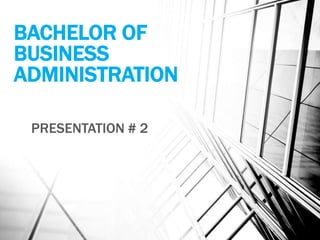
Bachelor of business administration
- 2. MOBILE COMMERCE • GROUP MEMBERS : • MUHAMMAD MUGHIRA (FA16 BBA(A) 112) • MUAZ JAVED (FA16 BBA(A) 043) • HAIDER JAFFER (FA16 BBA(A) 109) • MUNEEB AHMAD (FA16 BBA(A) 167) • AHMAD TOUSEEF (FA16 BBA(A) 018) • HAIDER AFZAL (FA16 BBA(A) 119)
- 3. MOBILE COMMERCE: Definition : The term “M-Commerce” stands for mobile commerce, and it’s the browsing, buying and The selling of products and services on mobile devices
- 4. Sub Fields Financial Services : It includes the handled devices specifically used by customers for mobile banking to access their accounts and pay the bills as well as brokerage services and Stock exchange. Telecommunications : The communication, Services charges, and the Reviews conducted to the user at same handheld device as a result of communication purpose. Services/Retail : The Services provided to the customer on the Go. Such as the services like online shopping at retail store and payment of the order through it. Information Services : This includes the financial, social, sports figures and traffic updates on almost every single field of communication. Monitoring Data is one of its unique usage.
- 5. Use in Real Life • Mobile Payments. • Mobile money transfer and M-banking. • Mobile financial services. • Purchases on mobile webs and apps
- 6. Any Significant Relevance of Management of Mobile Commerce • More than one-third of consumers are more likely to access technology-related functions. • More efficiently to consumers, especially millennial that use mobile devices most frequently. • In well known restaurants order taker take the order via tablet and charge the customer through the mobile application installed on that tablet. • The study displayed that customers prefer to use their smart phones for looking up information and locations for restaurants, browsing menus, reading reviews. • 25 percent of individuals said that they use their mobile devices to pay for meals several time a year.
- 7. Tools and Technologies Hardware: These are the physical components that we can touch or feel. E.g. Cellular phones. Software : Software is the set of instructions given to the computer. E.g. Micro browser, operating system(OS), Bluetooth. Network and access : In network access we have wireless transmission media, microwave, satellites, radio. Wireless network : The network which is connect without any wire is called wireless network. E.g. Bluetooth and Wifi.
- 8. Limitations Risk factor : Hacking chances are more often when to transfer data. Connectivity : M-commerce need high speed wireless connectivity, it is difficult to purchase. Health Hazard : It’s unsafe when we use mobile in driving and its radiation also effect the eye. Small Screen : Mobile has no longer screen like laptop and desktop so, sometimes user tried to navigate. Security Issue : M-commerce our data does not safe. Leads to low customer confidence. Power Consumption : Battery life decrease and power consumption increases
- 9. FUTURE OF MOBILE COMMERCE • In 2017 e Marketer projects, the share of US m-commerce sales that come from smart phones will grow to 65%—up from 58%. .This image showing us the growth rate of retail sales registered on smart phones during 2016.
- 12. Created by • MUNEEB AHMAD